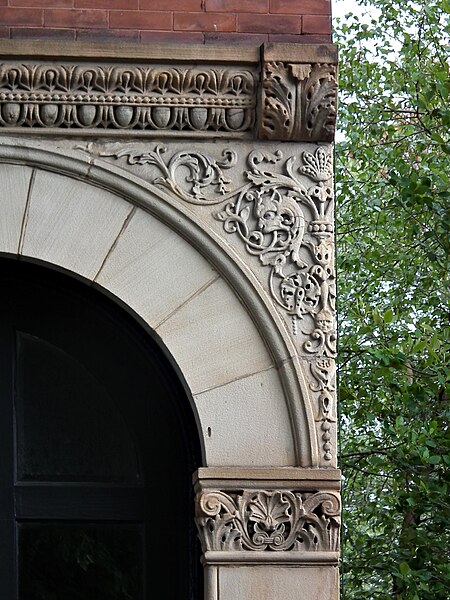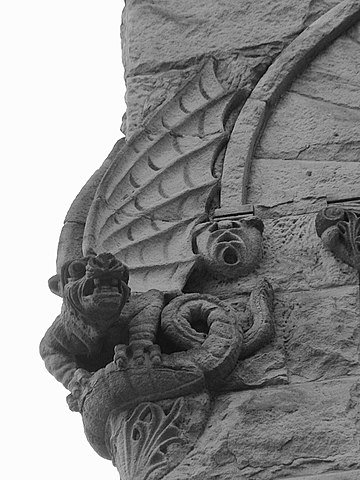Achille Giammartini
Achille Giammartini was responsible for a great number of architectural decorations in the city of Pittsburgh. His specialty was Romanesque relief carving, and his work is still to be seen wherever expensive Romanesque churches, commercial buildings, and houses still stand.
Achille Giammartini was born in 1861.1 He advertised himself as a pupil of Ettore Ferrari, the famous Italian sculptor; but whereas Ferrari often made heroic statues suitable for piazzas, Giammartini specialized in architectural decoration. (We note that the mania for classical names in 1800s Italy made Achilles the pupil of Hector.)
An Achille Giammartini is listed among stonecutters and masons in an 1882 guide to Rome. This is very likely to be our Achille, since it is an unusual name. He came to America in 1883, settling first in Boston, and working there and in New York and Cincinnati.2 By 1895 he had a long list of credits in Pittsburgh, as we see in this advertisement from J. M. Kelly’s Handbook of Greater Pittsburg for 1895:
This advertisement lists his studio as on Duquesne Way (now Fort Duquesne Boulevard), and his home in Allegheny on Page Street—then No. 92, later No. 1410, a house that still stands, festooned with the owner’s handiwork.
There is a touch of whimsy in almost everything Giammartini did, and we suspect that almost all the carved Romanesque decoration in the city was done by Giammartini. Frederick Osterling, in his Romanesque phase, seems to have made much use of him. Here is a gargoyle on the Marine Bank, one of the buildings listed in the advertisement:
The decorations on the Times Building could hardly be by anyone else:
Giammartini did some work on the College of Fine Arts building at Carnegie Tech, now Carnegie Mellon University. By this time, he seems to have been known as “Archie.” The inspirational motto “CREARE” over the entrance was carved by him. “He and Hornbostel knew each other’s work and brought out each other’s best qualities,” according to Charles Rosenblum, an architecture professor at Carnegie Mellon. “The drawings he had to execute from were pretty rough. He had quite a bit of artistic license and flexibility.”3
The advertisement in Kelly’s Handbook lists only one building outside Pittsburgh. A glance at Google Street View reveals that the Merchants’ National Bank in Clarksburg, West Virginia, is still standing, with Giammartini’s unmistakable work still in good shape.
Giammartini had two daughters, both of whom went to the Indiana State Normal School in Indiana, Pennsylvania.4
At some point around the First World War, Giammartini’s health declined to the point where he was forced to retire. He died in 1929, at the age of 68. He had been in a hospital in Atlanta, where one of his daughters lived; his death was front-page news in the Atlanta Constitution, and we reproduce the report in full here:
Noted Sculptor Dies.
Achille Giammartini Passes at Local Hospital.
Achille Giammartini, 68, of Pittsburgh, Pa., noted sculptor, died Sunday morning at a private hospital here, following an extended illness.
Mr. Giammartini’s work are in many of the leading cities in the United States, especially in the east. He made famous the applied design building at the Carnegie School of Technology, in Pittsburgh, one of the finest of its kind in the country.
He was well known in Atlanta, having visited his daughter, Mrs. George B. Little, many times. He retired from active work about 12 years ago, because of failing health. He had been confined to a local hospital for several months.
In addition to his daughter, Mrs. Little, he is survived by another daughter, Mrs. C. B. Bauer, Jr., of Pittsburgh, and several grandchildren.
The body will be taken this morning to Pittsburgh for funeral services and interment, with H. M. Patterson & Son in charge.
Works by Achille Giammartini
Here is the beginning of a list of Giammartini’s works. We hope to expand it a great deal, since he is known to have worked on many more buildings than these, and especially a great number of private houses.
Known to be by Giammartini
Masonic Building (Pittsburgh) (probably gone)
German National Bank (Granite Building)
Lincoln National Bank (probably gone)
Bell Telephone Building
Chronicle Telegraph Building (gone)
Marine National Bank
Masonic Building (Allegheny, North Avenue)
Liberty National Bank (East Liberty; ground floor altered)
Hussey Building (gone)
Christ Church (now First United Methodist)
College of Fine Arts, Carnegie Mellon
Fifth Ward Manual Training School (Page Street, Manchester)
Franklin School (gone)
1410 Page Street (Giammartini’s home)
Wabash Terminal (gone)
Aspinwall Filtration Plant
Merchants’ National Bank (Clarksburg, W. Va.)
Probably by Giammartini
☛Anyone who has definite information about the buildings on this list is earnestly invited to submit a reply at the bottom of the page.
Times Building
Maginn Building
Calvary Methodist Church (Allegheny West)
1334 and 1336 Pennsylvania Avenue (Manchester)
843 Beech Avenue (Allegheny West)
Tabernacle Baptist Church (Mexican War Streets)
Trinity Methodist Protestant Church (Manchester)
According to this skeletal listing at askART. Since he died at 68 in 1929, he would have been born in either 1861 or 1860. ↩︎
Walter C. Kidney, Henry Hornbostel: An Architect’s Master Touch, PHLF, 2002, p. 227. ↩︎
They are listed with their married names among the alumni in this issue of the Normal Herald, and the married names match the names in Achille’s obituary. Augusta, or “Gus,” or “Miss Martini,” was noted in 1913 as ”a belle when it comes to dancing Saturday nights.” ↩︎




